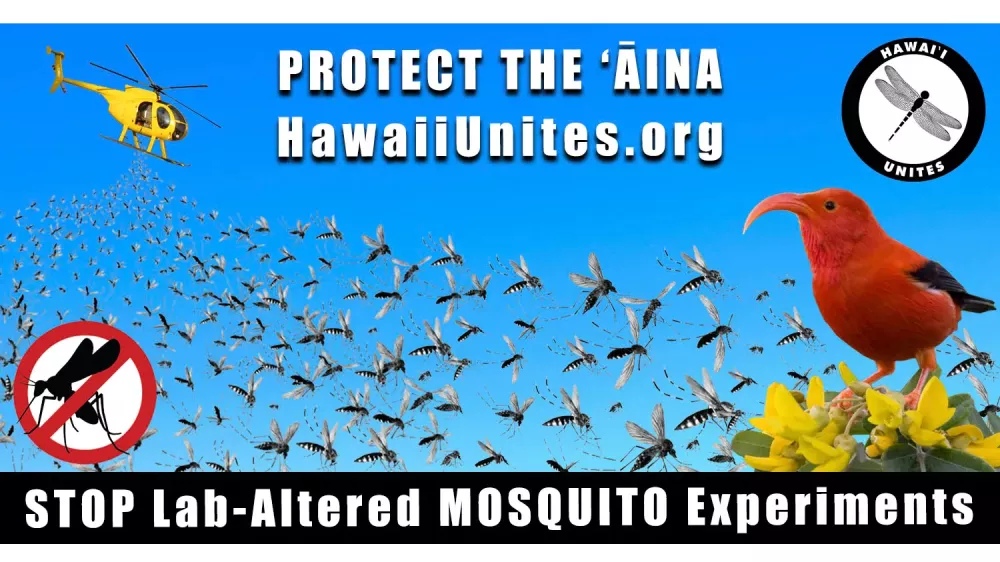Hawaii Unites to Stop Mosquito Experiments on Maui
Goal:
USD $100,000
Raised:
USD $13,511
Campaign funds will be received by Hawaii Unites
Hawaii Unites to Stop Mosquito Experiments on Maui
Help us protect the health of Hawaii's people, wildlife, and 'āina from this dangerous biotech industry agenda.
Hawaii Unites has an active court case against the State of Hawaii Board of Land and Natural Resources and Department of Land and Natural Resources for failing to prepare an Environmental Impact Statement for their Bacteria-Infected Mosquito Experiment on Maui. We’re continuing to raise funds towards legal fees as our case to stop these mosquito releases moves through the courts.
The State of Hawaii and its multi-agency partnership Birds, Not Mosquitoes plan to release up to 775,992,000 biopesticide lab-reared Wolbachia-bacteria-infected mosquitoes per week on Maui for the next 20 years. This effort to suppress mosquitoes that transmit avian malaria could actually cause the extinction of the native honeycreeper birds it's meant to save. Federal documentation confirms that the outcome is unknown and that this plan may not even work for its intended purpose. Peer-reviewed studies show the potential for increased spread of disease to people and wildlife and for the wild mosquito population to be replaced with the lab-altered mosquitoes.
Mosquitoes are already being released in the 64,666-acre East Maui project area. This specific mosquito technology has never been documented as used before for stand-alone field release, and the Maui project area is the largest Wolbachia mosquito release of any kind globally to date. If this project continues, over 40 BILLION invasive lab-altered mosquitoes could be released every year on the island of Maui!
These mosquitoes are infected in the lab with Wolbachia, a bacteria that could cause them to become more capable of spreading diseases like avian malaria and West Nile virus (bird and human). Tropical disease expert Dr. Lorrin Pang has expressed concerns about horizontal transmission of the lab bacteria to wild mosquitoes and other insect vectors of disease, stating: “Hawaii has a bad history of invasive species entering and spreading unabated, including their spread of infectious diseases.” He asks, “How is this supposed to be self-contained?”
The agencies involved in these releases have lied about the introduction of foreign organisms to the islands and about the release of female mosquitoes that bite, breed, and spread disease. Mosquitoes for this project originate from Palmyra Atoll. Wolbachia bacteria for the project originates from Kuala Lumpur in Malaysia. At least one strain of Wolbachia planned for import in connection with the project does not exist on these islands. Sorting techniques are imperfect, and female mosquitoes are being released. Once these mosquitoes are let loose in the environment, it is irreversible.
An Environmental Risk Assessment for these biopesticide mosquitoes has not been conducted by the EPA. There are no documented biosecurity protocols for the mosquitoes. Pathogen screenings of the lab mosquitoes are unknown, and that information is being withheld from the public. Male mosquitoes released can transmit bacteria and pathogens to females who could then spread disease to native birds, wildlife, and people. Assertions of no human health risks are based on unsound science that has been discredited by the EPA.
Helicopter and drone flight release methods increase the risks of wildland fires, impact the viewscape and the untrammeled natural qualities of the wilderness character, and cause noise disturbances to forest bird breeding and nesting.
This plan is an experiment on our island home. There are serious risks, and the outcome is admittedly unknown. Who will take responsibility if something goes wrong? Studies and research have not been conducted by these agencies; and safer, less experimental alternatives have not been considered. Conflicts of interest have not been disclosed or addressed, and the state is rushing forward with these releases without the consent of the people of these islands.
Public testimony has shown overwhelming opposition to these mosquito releases. We do not accept the Environmental Assessment’s Finding of No Significant Impact (FONSI). We’re calling for a halt to this project. The scope, risks, and experimental nature of the plan require detailed, comprehensive studies and documentation of the impacts to our native birds, wildlife, environment, and public health. We demand an Environmental Impact Statement (EIS).
Please consider making a tax-deductible donation to our organization to help us in our efforts. Any amount you can contribute will strengthen our cause.
Mahalo to everyone for your commitment to protecting the ‘āina from this dangerous biotech experimentation. We stand united in our love for these islands and our respect for the spiritual connection of the lands and the native birds.
Recent Donations
Thank you all for fighting this!
Thank you for your hard work and raising awareness and fighting for this issue.
Good luck!!
may love win...for the earth and all beings
GOD bless your Campaign - continued prayers for the people in HI & our world ...
praying for victory!
may love and nature prevail...thanks so much for doing this tina lia!
This is a perfect example of the adage "just because you can do something doesn't mean you should". There is no place in this world where this kind of bioterrorism insanity should be allowed. Lock up the people behind this and throw away the key!!!
Peggy
Hope you prevail in appeal.
Am certain that very few of the people of Hawaii consent to being guinea pigs in this massive public experiment of corrupting mother nature. This monstrous mosquito release would be as tragic as the lack of authentic informed consent of recent covidian times. With potentially greater negative impact on flora, fauna, the future, and "forever." This is a bad idea all around.
Mahalo!
Thank you for taking on this important issue!
Updates
Mahalo for Your Support as Our Court Case Moves Forward
June 8th, 2024
The State of Hawai'i and its multi-agency partnership are releasing millions of bacteria-infected mosquitoes in East Maui. The agencies involved have not studied the potential serious risks to the health of our island's people, wildlife, and 'āina. They've lied about the introduction of foreign bacteria and about the release of female mosquitoes that bite, breed, and spread disease. Their blatant procedural deviations are increasing the risks of wildland fires and helicopter accident incidents.
Hawai‘i Unites has taken the Department of Land and Natural Resources and their Board to court to stop this reckless experiment on Maui. We can set a precedent with this case to strengthen Hawai‘i’s environmental laws for all islands and to impact the course of this agenda globally.
With your support, our case is continuing to move through the courts and is in the appeals process. Mahalo to everyone for your tax-deductible donations. We're grateful for your encouragement as we continue researching, documenting, and challenging this dangerous biotech insect agenda.
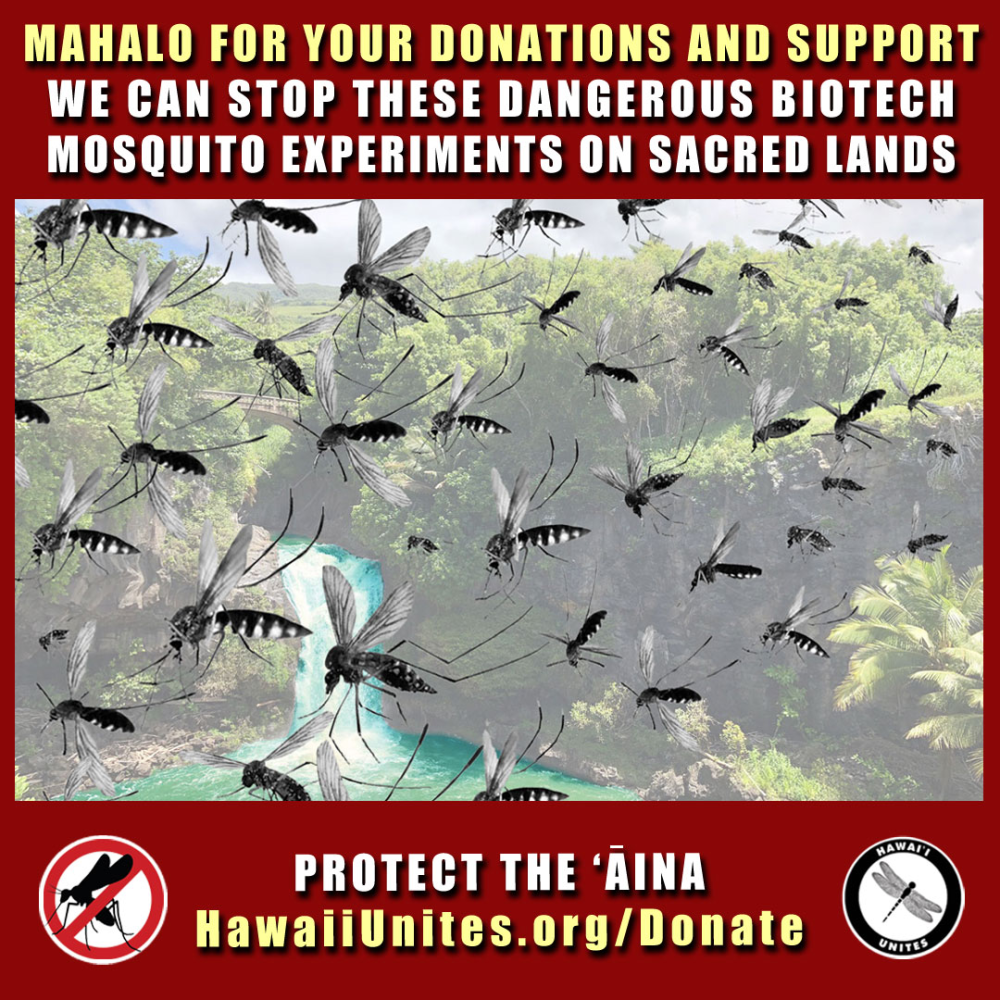
Court has Granted the State’s Motion for Summary Judgment in our Mosquito Case
February 1st, 2024
Donate now to help us raise $30,000 by the end of February 2024 so that we can file an appeal and continue challenging this project in court.
On January 29, 2024, First Circuit Court Judge John M. Tonaki issued an order granting the State of Hawai‘i’s motion for summary judgment in our case against the State of Hawai‘i Department of Land and Natural Resources and Board of Land and Natural Resources. This means that our case in environmental court seeking a ruling to require an environmental impact statement (EIS) for the bacteria-infected mosquito release experiment on Maui will not go to trial as scheduled. We also won’t be receiving discovery documents and admissions from the state that were due this week. We need your help to appeal this decision.
There are several issues with the Judge’s ruling that would be a focus of our appeal. First, Judge Tonaki’s order gives no detail about the expert testimony presented in our case that calls into question the sufficiency of the final environmental assessment (FEA) based on specific concerns and potential significant impacts to our environment and to the health of Maui’s people, wildlife, and ecosystems. Tropical disease and vector expert Dr. Lorrin Pang testified as a private citizen at our TRO and preliminary injunction hearing about the state’s lack of study of the risks of the project that could cause irreversible harm to our island home. Dr. Pang has authored over 75 publications in peer-reviewed medical journals covering a broad range of studies, over 40 of which are focused on mosquito-borne illnesses. He has mitigated mosquito-borne illnesses, including dengue and Zika, for over two decades as a public health leader on the islands. The court failed to acknowledge Dr. Pang’s serious concerns about horizontal transmission of introduced bacteria, biopesticide wind drift of lab-altered mosquitoes into unintended areas, superinfection of mosquitoes with multiple bacteria strains, increased pathogen infection and disease-spreading capability in mosquitoes, and the experimental nature of the project – all issues that were insufficiently addressed or missing entirely from the FEA, and facts material to the lawsuit.
Next, the order granting summary judgment does not address the state’s failure to properly follow Hawai‘i Administrative Rules (HAR) regarding proper identification and documentation of public comments in the FEA. As described in our memorandum in opposition and argued in the hearing, in addition to the sorely inadequate assessment of the risks involved for humans and other species (including the endangered birds), this failure to follow the law makes it impossible to know if any concerns submitted in public comments were properly addressed. The Board of Land and Natural Resources accepted an FEA for the mosquito release experiment and issued a “Finding of No Significant Impact” (FONSI) based on a flawed document, violating the letter and purpose of the Hawai‘i Environmental Policy Act (HEPA). The state acknowledged in their own motion that they failed to follow HAR, suggesting that the rules were irrelevant. This undermines public trust in the entire process.
Additionally, Judge Tonaki does not appear to have considered the substantial procedural deviations from the approved FEA that are documented in our memorandum. We believe that mosquitoes are being released solely by helicopter rather than drones up to this point, and that the release system described in the FEA is not the system being used. This means that helicopters are flying closer to the tree canopy than the level stated in the FEA, increasing the potential for adverse impacts such as noise disturbances; nesting, breeding, and roosting disturbances; helicopter rotor wash; accidents and collisions; and wildland fires.
If the Judge’s decision is not appealed, it will set a precedent for allowing inadequate environmental review of future proposed experimental projects that could have significant impacts to our fragile ecosystems.
While we are very disappointed in Judge Tonaki’s decision, Hawai‘i Unites will not stop researching and documenting the risks of this dangerous bacteria-infected mosquito release experiment. With your support, we can appeal this summary judgment order and seek a ruling that our case be remanded back to the circuit court and go to trial. If we continue to move forward, legal fees and other associated costs will be ongoing. We anticipate that at least $100,000 will be needed.
We’re so grateful for everyone’s encouragement and contributions, and for our excellent attorneys who have been working patiently with us while we raise funds for our case. We will be making an important decision in the weeks ahead.
If our organization can raise $30,000 by the end of February 2024, we will file an appeal. Please consider making a tax-deductible donation to help us continue challenging this project in court.
Legal action is our best chance of stopping these mosquito releases, and we hope to have the resources to take this David and Goliath battle to the next level.
Mahalo,
Tina Lia
Founder
Hawai‘i Unites
HawaiiUnites.org
Hawai‘i Unites is a 501(c)(3) nonprofit organization dedicated to the conservation and protection of our environment and natural resources. Your tax-deductible donations help us to fulfill our mission of honoring and protecting our sacred connection to the natural world.
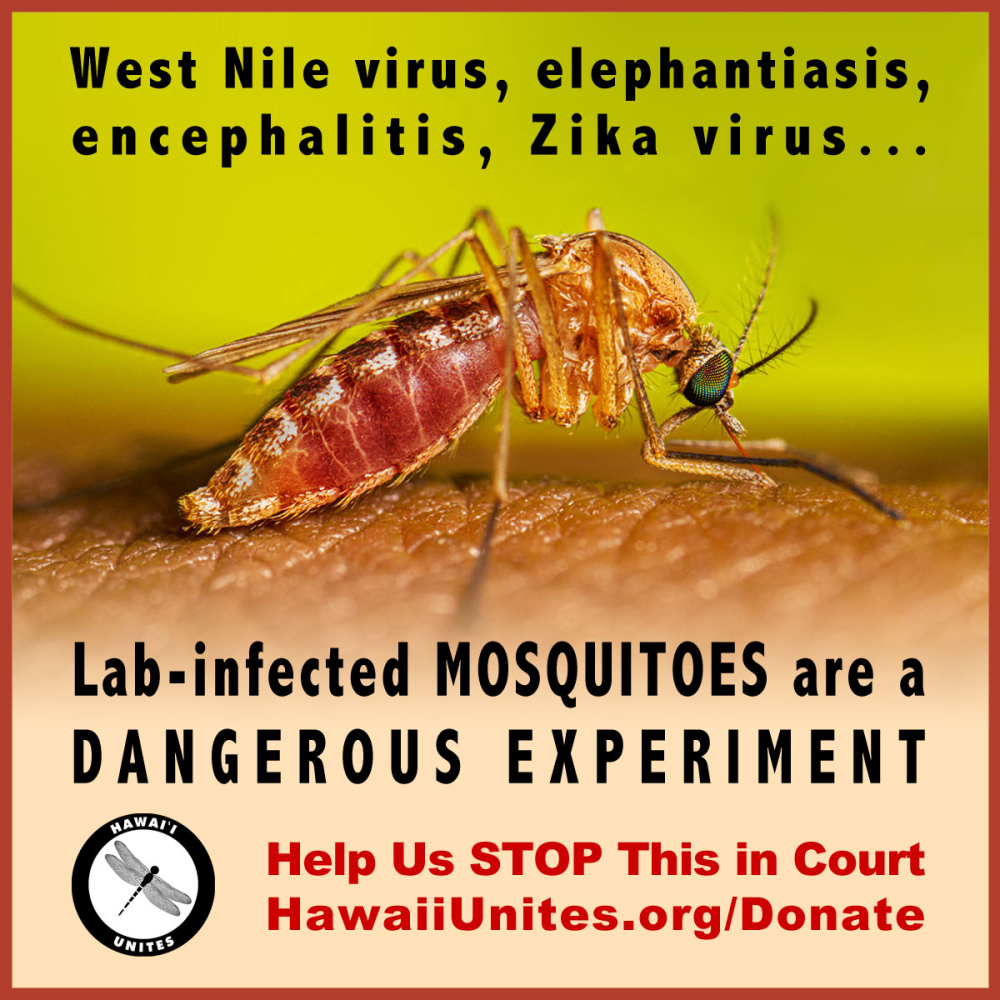
Female Mosquitoes Bite, Breed, and Spread Disease: They Will Be Released
November 5th, 2023
Female Mosquitoes Bite, Breed, and Spread Disease: They Will Be Released
Agency partners releasing bacteria-infected mosquitoes in Hawai‘i are lying to the people
At last month’s Hawai‘i Board of Land and Natural Resources (BLNR) meeting, bacteria-infected mosquito releases were voted through unanimously for the island of Kaua‘i. These dangerous mosquitoes are already being let loose on Maui despite our active case in court, and larger scale releases are planned for the East Maui project area this month. While we await a decision on our Petition for a Contested Case Hearing, the agencies involved wasted no time in unleashing mosquitoes on Kaua‘i less than two weeks after the board vote. With faithful allegiance to the biotech industry, one project leader went as far as to call the invasive lab-altered insects “the savior mosquitoes.”
As the BLNR continues to railroad this potentially catastrophic plan through despite serious risks to the health of the people, native birds, wildlife, and environment, their multi-agency partnership Birds, Not Mosquitoes (BNM) is scrambling to cover their tracks. BNM’s misinformation campaign is falling apart in real time. Our investigative team has been scouring these agencies’ own documents for well over a year now, and we’ve repeatedly pointed out the deceptive statements presented by BNM. One of those falsehoods concerns the release of female mosquitoes. From day one, BNM has carried on with the story that only male mosquitoes will be released for this project, tossing out ever-changing figures with no documentation to back those claims. What we found early on is that female mosquitoes that bite, breed, and spread disease will be released – thousands per week are allowed on Maui alone. With indisputable facts on the record, the state’s legal team is now attempting to backtrack BNM’s previous statements while downplaying the hazards these bacteria-infected females pose.
Agency partners in Birds, Not Mosquitoes will continue attempting to deceive the public about the serious risks of these bacteria-infected mosquito releases. They’ve got an insectary to fund right here in Hawai‘i, and their intention is to mass-produce these lab-altered mosquitoes for release on the islands into perpetuity (forever). This first phase of their plan is a trojan horse that opens the door to the state’s long-term goals of producing and releasing CRISPR gene-edited mosquitoes, synthetic biology control tools, and gene drives into our environment. This irreversible desecration of sacred lands endangers the health of Hawai‘i’s people, native birds, wildlife, and the ‘āina.
You can help us stop this biotech experimentation agenda from escalating. Hawai‘i Unites has filed a case in environmental court seeking a ruling to require an Environmental Impact Statement to study the potential significant impacts of this project and to consider alternatives. We also have a hearing in progress for our Temporary Restraining Order and Preliminary Injunction to stop the release of mosquitoes in East Maui. Please consider making a tax-deductible donation to our organization to support our legal case and set a precedent for the voice of the people in the decision-making process. The corporations behind this technology want to use these islands as testing grounds. If we can prevent this travesty from continuing to threaten the well-being and safety of Hawai‘i, we will be a beacon of hope for a global movement to protect our natural world and the health of our communities for generations to come.
Mahalo,
Tina Lia
Founder
Hawai‘i Unites
HawaiiUnites.org
Hawai‘i Unites is a 501(c)(3) nonprofit organization dedicated to the conservation and protection of our environment and natural resources.
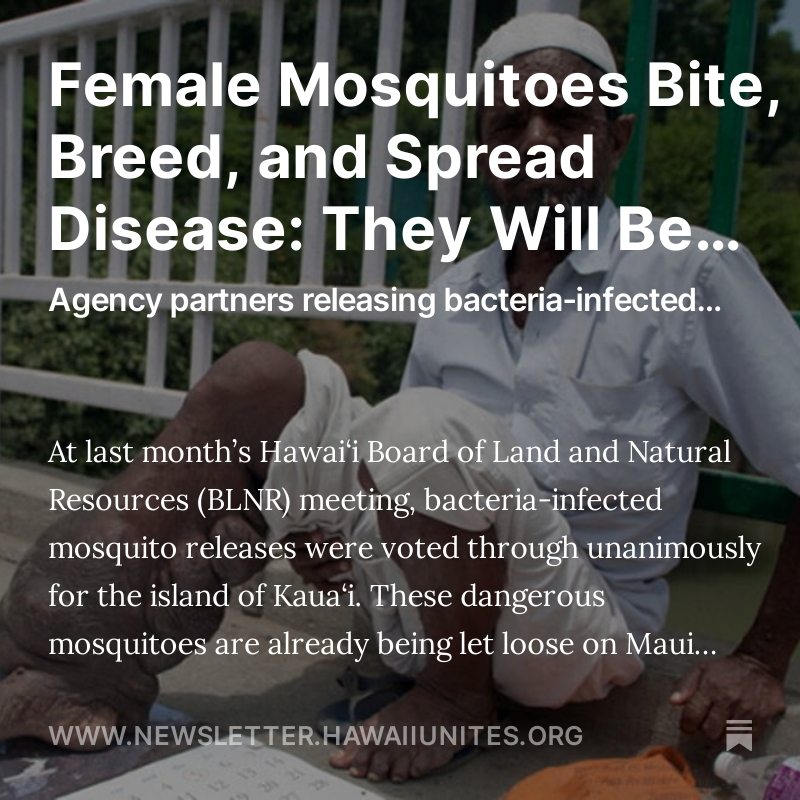
Bacteria-Infected Mosquitoes on Maui and Kaua‘i: All Islands are Being Targeted
October 23rd, 2023
Bacteria-Infected Mosquitoes on Maui and Kaua‘i: All Islands are Being Targeted
On 10-13-23, the Hawai‘i Board of Land and Natural Resources (BLNR) once again disregarded the will of the people and voted to plow forward with their plan to release bacteria-infected mosquitoes on the island of Kaua‘i. Dismissing serious risks brought to their attention by testifiers who have worked tirelessly for over a year to protect the islands from this dangerous project, the board continues to push on with their predetermined agenda that prioritizes corporate interests and biotech industry experimentation over the health of all life in Hawai‘i. They’ve got a lot of funding on the line, and they’re determined to keep that money rolling in as they plan to build out their insectary and mass produce these lab-altered mosquitoes for release on the islands into perpetuity.
As usual, the BLNR rearranged their meeting items at the last minute and moved the mosquitoes to the end of the day, forcing testifiers to sit through almost eight hours of unrelated discussion. When the mosquitoes finally came up, Department of Land and Natural Resources’ (DLNR’s) David Smith opened by announcing that a Hawaiian oli (chant) would start the state’s presentation. One brave testifier representing the Native Hawaiian community stood up and walked out of the room at that point, addressing Smith directly to let him know that this was “cultural misappropriation” and an embarrassment. At that, board members – along with deputy attorney general Miranda Steed – erupted in laughter. Another attorney defending the state against Hawai‘i Unites in our court case challenging the mosquito releases boisterously exclaimed “a hui hou” as the testifier made her way out. So much for respecting the people’s voice.
BLNR Meeting 10-13-23: Kaua‘i mosquito agenda item C1 begins at 7:50:32 (Video)
The presentation continued with DLNR’s Cynthia King. An entomologist who studies insects, King chose not to speak on the lab-altered mosquitoes planned for release, focusing instead on birds (not her specialty). Providing no data to back her claims, she described a climate change crisis causing mosquitoes to invade higher elevations on Kaua‘i where native honeycreepers are threatened by avian malaria that the mosquitoes transmit. Her primary narrative was that the ‘akikiki bird found only on Kaua‘i is expected to be extinct in the wild by the end of this year. She suggested that thereafter, the ‘akikiki will only persist in Hawai‘i’s conservation recovery centers (as captives).
David Smith jumped in again at that point to describe how just a few months ago, they were still seeing between 60-100 ‘akikiki birds in the wild. Now they only know of five birds left. No explanation was given by Smith as to what may have actually happened to those other 55-95 ‘akikiki since earlier this year, but a February 2023 Kaua‘i Forest Bird Recovery Project Avicultural Specialist job application offers some clues:
"Position will last from late February until early July 2023. The project focuses on a critically endangered, endemic Hawaiian songbirds, the akikiki. With only 45 birds left in the wild, we have determined that capturing them and transferring them to managed human care facilities is the best way to prevent the imminent extinction of the species..."
Can we get a count of the ‘akikiki birds caged and/or inadvertently killed by “specialists” who have determined that capturing them and transferring them to managed human care facilities is the best way to prevent the imminent extinction of the species? Probably not.
Smith raised the alarm about how the DLNR is now looking at other species being next up for extinction from the same slippery slope narrative. He did note that ‘amakihi, one of the most common native forest birds, are doing pretty well on Maui. What he didn’t mention is that ‘amakihi are doing well because they’ve developed a natural tolerance and resistance to avian malaria. We may never know if the endangered ‘akikiki could also develop such a resistance if left alone in nature without human interference. Smith and his cohorts are narrowly focused on the release of millions of bacteria-infected mosquitoes in the birds’ natural habitat as the only solution, despite evidence that the lab-altered mosquitoes themselves could potentially cause the honeycreepers’ extinction.
BLNR Chair Dawn Chang then excitedly suggested that the state explore the legality of using the governor’s emergency proclamation powers “to save our most endangered birds.” With Hawaii’s state motto seemingly morphing into “Never let a good crisis go to waste,” I can’t say we didn’t see that coming.
DLNR’s David Smith brought the talk back to releasing lab-altered mosquitoes, explaining that “we’ve done it on Maui, and we’re starting to get birds on the ground over there.” Well, that doesn’t sound good. I’ll give him the benefit of the doubt and assume he misspoke. He went on to describe the Mark Release Recapture studies, which seem to be revealing disappointing results. According to Smith, these initial studies to determine how to move forward with the project are showing that the bacteria-infected mosquitoes are not spreading as much as the agencies involved thought they might. Unsurprisingly, the solution is that they may have to do more releases to get the coverage they’re looking for.
Chair Chang again emphasized how Smith’s update was making the situation seem more urgent. She requested data on the bird declines. An unnamed project proponent responded that updated data will be available in June of next year, stating that surveys are conducted every five years and were conducted this past spring with data requiring time to be analyzed. Chang persisted, saying that June may be too late, and suggesting that the presenters get her something now. Apparently, accuracy is not a priority when it comes to bird counts for this project. Chang went on to state that maybe there are actions they need to take now (hint: she wants that proclamation). “This is compelling. There’s an emergency,” she concluded.
My turn to testify offered a brief opportunity to bring some pertinent facts into the conversation:
Tina Lia Testifies Against Wolbachia Mosquito Releases on Kauai 10-13-23 (Video)
More compelling testifiers in opposition to the project followed, including Stand Together Hawaii’s Michelle Melendez and the community advocate who walked out of the meeting earlier in protest of the misappropriated Hawaiian chant.
Other testifiers spoke in favor of biopesticide insect science that they clearly had no understanding of. Some seemed genuinely concerned for the birds, though you would think they’d want to know more about the state’s refusal to study documented risks of an irreversible and potentially catastrophic experiment on their island home. It really is shameful that the agencies promoting this project have been intentionally misrepresenting the truth about what could go wrong. The DLNR’s own environmental assessment attempts to relieve them of all responsibility for what happens to the endangered honeycreepers as a result of the mosquito releases. Who will be held accountable? Their board that voted this plan through?
When the last in-person testifier was called up, we got our “a hui hou,” meeting again with the showy defense attorney representing the state’s agenda via the non-governmental organization Center for Biological Diversity (CBD). In what could be viewed as an attempt to litigate our legal case outside the courtroom, she directly addressed my testimony, responding with information presented by the state during our July 2023 Temporary Restraining Order and Preliminary Injunction hearing (still in progress). Her focus was on our expert witness from that hearing, tropical disease and vector expert Dr. Lorrin Pang. The same arguments used by the state to try to discredit Pang in court back in July were again dragged out as a desperate diversionary tactic.
In a surprise move, the CBD attorney’s testimony did confirm for the first time publicly that the state is allowed to release one female mosquito for every 250,000 males – a fact we uncovered in their own documents last year. What she didn’t say is that female mosquitoes bite, breed, and spread disease; or that one female released can produce 160,000 more females in her eight-week lifespan. She tried to downplay the risks of lab-infected females, neglecting to mention that just three females released in Singapore caused the mosquito population to be replaced with the lab-strain mosquitoes.
If the plan for Kaua‘i continues moving forward, mosquito releases could begin early next year. On Maui, despite our active court case, the project is accelerating with larger scale releases planned to start next month.
Hawai‘i Unites is in a David-and-Goliath battle to stop this monstrous mosquito invasion from destroying the natural beauty and health of the Hawaiian Islands. Please help us set a precedent for all islands to protect the environment from biotech industry takeovers.
Your tax-deductible donation to our organization empowers us as we take on this epic courtroom challenge.
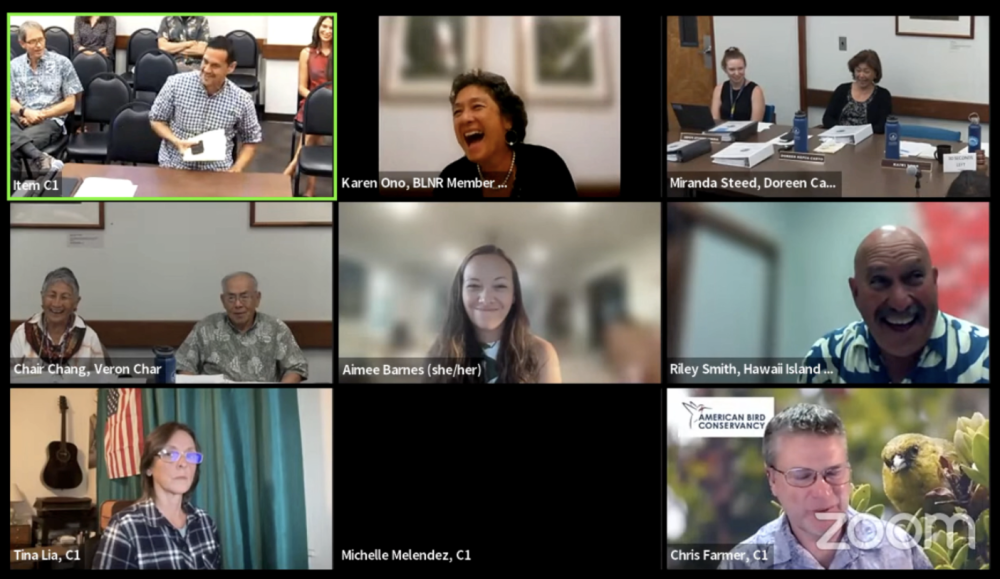
Hidden Agenda: Hawai‘i’s Secret Mosquito Lab
July 4th, 2023
DLNR to Mass Produce Lab-Altered Mosquitoes
Recent news about the reemerging cases of human malaria in Texas and Florida has many of us concerned about the possible connection between the transmission of this mosquito-borne illness and the release of lab-altered mosquitoes in both states. In the last few years, Texas and Florida have both released Oxitec GMO mosquitoes as well as lab-infected Wolbachia mosquitoes similar to the ones being released now in Hawai‘i. With the State of Hawai‘i’s multi-agency partnership Birds, Not Mosquitoes pushing for the use of these infected mosquitoes throughout the island chain, we have every reason for alarm.
Adding to the potential for unknown consequences in Hawai‘i, the lab-infected mosquitoes being used here are experimental and have never been released for this purpose anywhere in the world. This is the first time ever that southern house mosquitoes are being used for Wolbachia stand-alone field release, and the East Maui project area is over 89 times the size of the largest Wolbachia mosquito release of any kind globally to date. The agencies involved have openly admitted that females who bite and spread disease will be released. EPA guidelines allow for over 3,000 females weekly to be let loose on East Maui. Just one female can produce 160,000 more females in her eight-week lifespan. That’s a lot of biting disease vectors.
There are no documented biosecurity protocols for these mosquitoes, and pathogen screenings are unknown. Southern house mosquitoes transmit human diseases, including West Nile virus, elephantiasis, and St. Louis encephalitis; and they’re a potential vector of Zika virus. Peer-reviewed studies have shown Wolbachia bacteria to cause mosquitoes to become more capable of spreading both West Nile virus (bird and human) and avian malaria. Not only are the mosquitoes a risk to public health, but this project could cause the extinction of the endangered native birds it’s supposed to save.
Agency partners plan to release over 40 billion mosquitoes a year on Maui alone. All islands are being targeted, and mosquitoes are already being released in East Maui. We’ve filed a TRO and preliminary injunction to stop this. Releases on Kaua‘i are next, and that project area is almost as large as the project acreage on Maui. The comment deadline to oppose this on Kaua‘i is July 24th. A sample comment is available at HawaiiUnites.org.
The public has been misled to believe that these mosquitoes are only being used to address avian malaria in remote forest landscapes. The truth is that approvals are already in place for ground release “to control mosquitoes of public health concern.” The Department of Health is running their own program targeting human health with these mosquitoes. No information about the details of their plan has been disclosed to the public.
What we uncovered this week is even more shocking. The State of Hawai‘i’s Department of Land and Natural Resources (DLNR) already has a secret mosquito lab here on the islands. They’ve been funded by unknown sources to build out the insectary where they intend to mass produce 400,000 lab-infected mosquitoes every month for release throughout Hawai‘i. Not only are they planning to produce billions of dangerous Wolbachia-infected mosquitoes, but they have lied to the public about their intent to release genetically modified (GMO) mosquitoes. The DLNR will actually be producing GMO mosquitoes here in their Hawai‘i lab using pgSIT (precision guided sterile insect technique) CRISPR technology, once research and development are complete.
This mosquito mass production and release plan is intended to continue “in perpetuity” (forever). These agencies have prioritized a cash cow of biotech funding above the will of the people whose health they’re putting at risk with these projects. Now that the money has started rolling in, this scheme will continue to escalate if left unstopped. Gene drives, synthetic biology control tools, and even CRISPR tech genetic modification of forest birds are in the bigger picture plan.
Is the State of Hawai‘i setting the stage for emerging mosquito-borne human disease cases like the ones now happening in Texas and Florida? There’s big money in pushing these lab-altered mosquitoes, and the public often becomes unconsenting test subjects for the biotech corporations behind the products and patents. With a state agency already running a secret lab to implement its hidden agenda, we do have to ask what else they may have opened the door to here in Hawai‘i. Is our state the next hot spot for bioweapons research? Have these activities made us even more vulnerable to a bioterrorism attack in the Pacific Region?
The people of these islands are overwhelmingly opposed to these mosquito releases. We don’t want to be human subjects for biotech experiments. Mosquito labs supplying this program have ties to funding from highly concerning sources, including Bill Gates and George Soros. We’re being targeted by corporate interests and global government overreach.
If you’ve been on the fence about publicly opposing this project, now’s the time to make your voice heard. For anyone still actively supporting this escalating mosquito release agenda with full knowledge of what’s being planned for these islands, you need to start answering to the communities affected by the decisions you stand behind.
We didn’t agree to this. Our volunteer activists have been working tirelessly for over a year to raise awareness about the risks of bringing these lab-altered mosquitoes onto the islands. We’re continuing to research and uncover more disturbing details of this plan, and we’ve taken action in court to stop it. The question is, will project partners continue to ignore the legal process along with our voice as a community?
Hawai‘i Unites needs your support to present a strong case against the DLNR and its board for pushing this unsafe experiment on the public and railroading it through without the consent of the people of Hawai‘i. Help us take this to court.
Your tax-deductible donations to our legal fund will move this case forward:
GiveSendGo "Hawaii Unites to Challenge Maui Mosquito Release"
You can choose to show your name as a contributor or remain anonymous. Please share this donation link with your contacts.
We’ve created a video of the information in this article to get the message out there. Share the link, and let’s make this story go viral:
Hidden Agenda: Hawai‘i’s Secret Mosquito Lab
Mahalo for all of the encouragement and contributions to our efforts.
Aloha,
Tina Lia
Founder & President
Hawaii Unites
Our Change.org petition now has over 5,500 signatures! Help us get to 7,500 to raise public awareness and make our voices heard: Demand an Environmental Impact Statement for the Experimental Mosquito Release on Maui
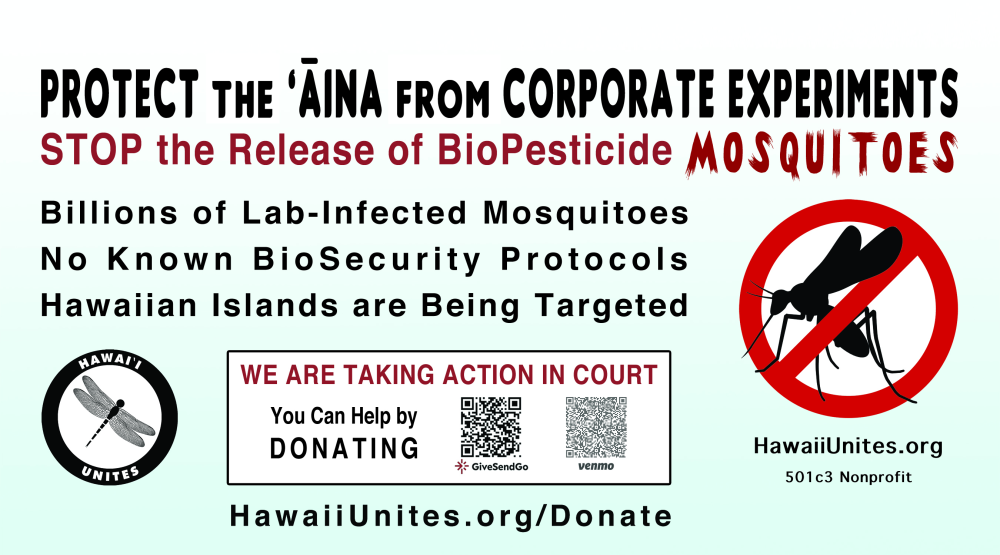
Hawaii Unites has filed a TRO and Preliminary Injunction to STOP the Release of BioPesticide Mosquitoes
June 23rd, 2023
Help Us Take This to Court
Early this month, we learned that despite our lawsuit in environmental court, the multi-agency partnership Birds, Not Mosquitoes (BNM) had already rushed ahead and released lab-infected mosquitoes in East Maui. According to BNM, “Small-scale pilot releases of Wolbachia-incompatible male mosquitoes started in mid-May after the Finding of No Significant Impact for the East Maui Environmental Assessment.” The specific locations, times, and details of these releases have not been disclosed.
What we do know is that last year, the Department of Land and Natural Resources improperly segmented these initial releases, called “mark release recapture” studies, from the overall project by filing an exemption notice. This means the studies are exempt from the environmental assessment, and no public information is available. Not only do we not know where, when, or how the releases are happening, but we don’t even know what type of mosquito is being transported, where the mosquitoes are being transported from, or whether or not the mosquitoes are being tested for pathogens prior to transport.
The exemption notice does offer the tax map keys for the potential release locations. We’ve mapped those sites where the current mosquito releases may be taking place.
After working with our attorneys to build a strong case, we filed a temporary restraining order (TRO) and preliminary injunction this week to stop these mosquito releases. A hearing is scheduled for July 21st, 2023.
We need your help to take this to court. All legal funds donated to date have now been expended, and we are over $20,000 short of reaching our goal for this first phase of litigation. Please get the word out to the community and help us challenge this dangerous mosquito experiment.
Your tax-deductible donations to our legal fund will move this case forward:
GiveSendGo "Hawaii Unites to Challenge Maui Mosquito Release"
You can choose to show your name as a contributor or remain anonymous. We appreciate everyone sharing this donation link and working together to raise the funds needed to halt these biopesticide mosquito releases.
Last week’s outreach event in Hāna was an important gathering of East Maui residents. Dr. Lorrin Pang (private citizen) and I shared our concerns about the mosquito project, and the community is now organizing weekly meetings to discuss action steps moving forward. Mahalo to Faith Chase of Farmers Voice Hawai‘i for hosting, and to everyone who showed up with thoughtful questions, suggestions, and care for the ‘āina.
If you’re in East Maui, please join the weekly meetings at Wananalua Congregational Church’s Mother Alice Hall on Wednesdays from 5:00-6:00pm.
Thank you so much to everyone for contributing your time and resources to raise awareness about protecting our environment, native birds, and public health from these biopesticide mosquitoes.
Aloha,
Tina Lia
Founder & President
Hawaii Unites
Our Change.org petition now has over 5,400 signatures! Help us get to 7,500 to raise public awareness and make our voices heard: Demand an Environmental Impact Statement for the Experimental Mosquito Release on Maui
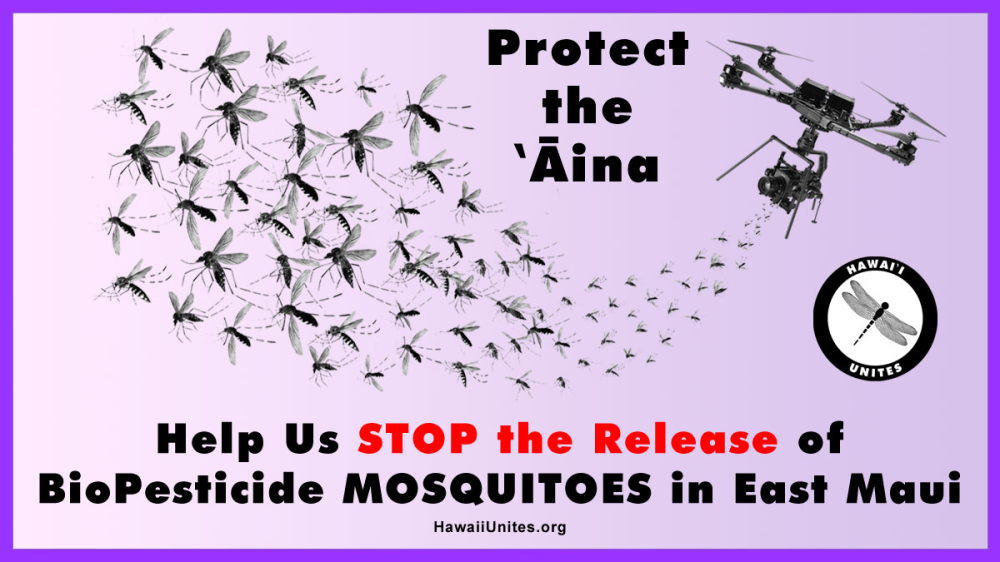
Help Us STOP the Release of BioPesticide Mosquitoes
June 9th, 2023
After filing our case in environmental court last month, Hawaii Unites learned that the multi-agency partnership Birds, Not Mosquitoes (BNM) had every intention of rushing ahead with their plan to release biopesticide mosquitoes despite the lawsuit. Now those releases have been confirmed. According to BNM, “Small-scale pilot releases of Wolbachia-incompatible male mosquitoes started in mid-May after the Finding of No Significant Impact for the East Maui Environmental Assessment.” Specific location details of the released mosquitoes have not been disclosed.
We’re working with our attorneys to stop these releases and will continue to keep everyone updated as we challenge this further. Our case against the Board of Land and Natural Resources and Department of Land and Natural Resources is moving forward, and a scheduling conference is set for August 3rd. Hawaii Unites is raising funds to cover legal fees, and we anticipate that at least $30,000 will be needed for the first phase of litigation.
You can choose to show your name as a contributor or remain anonymous. We appreciate everyone sharing this donation link with the community.
An important outreach opportunity is scheduled for next Thursday 6/15 in Hāna. Farmers Voice Hawai‘i will be hosting an informational meeting where Tropical Disease and Vector Expert Dr. Lorrin Pang (private citizen) and I will share our concerns with the East Maui community about this biopesticide mosquito experiment and answer questions about the project. The event is open to the public, and we hope to see you there:
New flyers are being printed that explain more about disease risks of the lab-infected mosquitoes. We encourage sending the online version out to your network and spreading the word about the dangers of this project to the health of our community, including the people of these islands, the endangered native birds and other animals, and our fragile ecosystems. Visit our website at HawaiiUnites.org to view the flyer.
Mahalo again for all the support for our efforts. Together, we will continue to challenge this dangerous experiment and speak out to protect the ‘āina.
Aloha,
Tina Lia
Founder & President
Hawaii Unites
Our Change.org petition now has over 5,000 signatures! Help us get to 7,500 to raise public awareness and make our voices heard: Demand an Environmental Impact Statement for the Experimental Mosquito Release on Maui
Recent Media:
The Ohio Brett Show: Ohio Brett ft. Melanie Roberts, Glenn Baker, Ron Symon & Tina Lia (5/17/23)
(interview starts at 39:14)
The Tenpenny Files, On Your Health: Dr. Sherri Tenpenny ft. Tina Lia & Lorrin Pang (5/15/23)
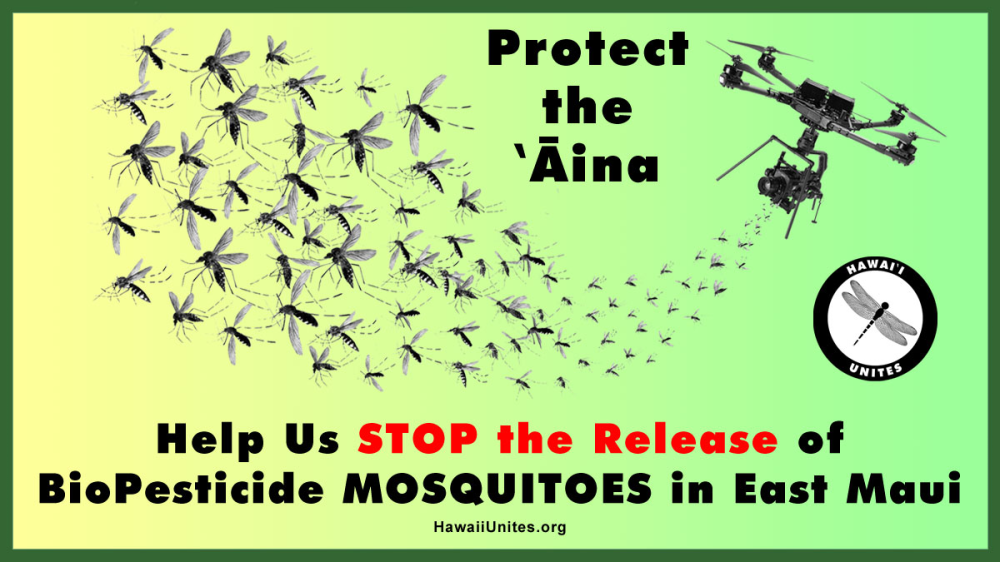
Live Interview Today with Dr. Sherri Tenpenny
May 15th, 2023
Live Interview Today with Dr. Sherri Tenpenny
Monday 5/15 at 1:00pm Hawaii Time
Hawaii Unites is gaining momentum and media coverage with our court challenge of the planned biopesticide mosquito experiment. We’re excited about today’s live interview with Dr. Sherri Tenpenny. Tropical disease and vector expert Dr. Lorrin Pang will be joining me to talk with Dr. Tenpenny about the risks and potential significant impacts of the state’s multi-agency plan to release millions of bacteria-infected mosquitoes weekly on our fragile East Maui ecosystems.
Tune in live on Brighteon TV today, Monday 5/15, at 1:00pm Hawaii Time, and catch the replay tomorrow on Dr. Tenpenny’s site.
We filed our case in Environmental Court last week challenging the Board of Land and Natural Resources’ and Department of Land and Natural Resources’ failure to complete an Environmental Impact Statement for the project. Our filing describes numerous risks the lab mosquitoes pose to wildlife and the 'āina that require further study. We’re also focused on the need for meaningful public participation in the decision-making process.
Last Friday, Hawaii Unites’ petition for a contested case hearing was on the agenda for the BLNR meeting. Mahalo to the community for showing up in support of our organization through written testimony, and a special shout out to everyone who hung in there for a wait of close to ten hours before our agenda item was addressed. We had some very powerful voices at that meeting. 100% of all testimony was in opposition to the release of the biopesticide mosquitoes and the state agency’s denial of our right to a contested case. Once again, the BLNR chose to disregard the will of the people, along with constitutional due process. Our petition was denied.
Project proponents have indicated that they intend to move forward with releasing the mosquitoes as early as this month despite the fact that there’s a lawsuit pending to determine if further study is needed. We will continue to challenge this in court, and we expect to have an update on our case in the days ahead. The lawsuit in environmental court is still active and is separate from the contested case hearing process.
Thank you to everyone for speaking out about this project. We’re united in our love for these islands, and we will not stop advocating for the protection of the 'āina.
Hawaii Unites is raising funds for our legal case. We anticipate that at least $30,000 will be needed for this first phase of litigation. Please consider making a tax-deductible donation to our organization's legal fund, and share this link with the community:
GiveSendGo "Hawaii Unites to Challenge Maui Mosquito Release"
Mahalo to the everyone for supporting our efforts.
Aloha,
Tina Lia
Founder & President
Hawaii Unites
Please continue to share our Change.org petition to raise public awareness and make our voices heard: Demand an Environmental Impact Statement for the Experimental Mosquito Release on Maui
Recent Media:
Honolulu Star-Advertiser: Group seeks to stop mosquito release into Maui wilderness (5/14/23)
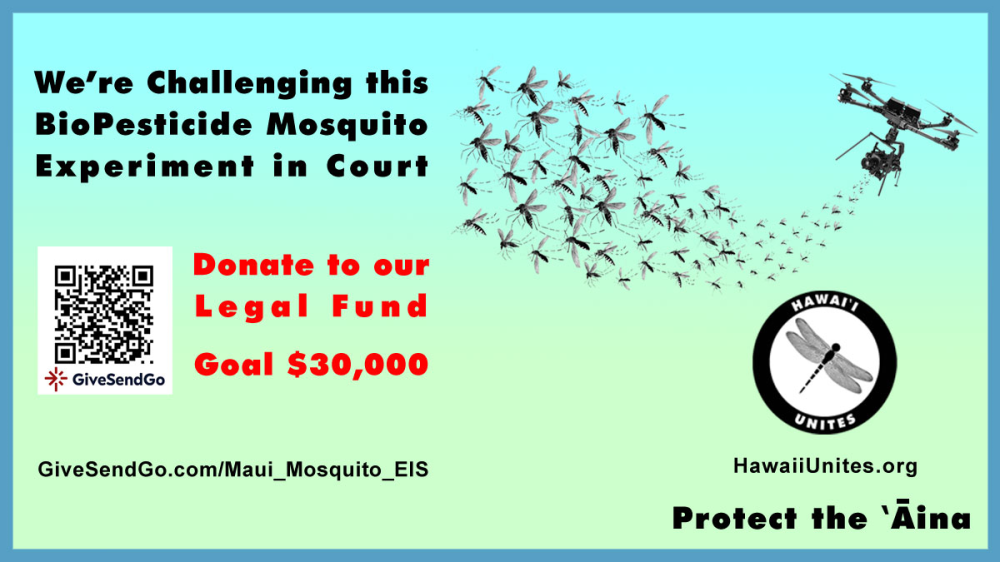
Hawaii Unites Challenges BioPesticide Mosquito Experiment in Court
May 9th, 2023
Mahalo to everyone for your contributions to our legal fund. Today (5/8/23) we filed our lawsuit against the State of Hawaii Board of Land and Natural Resources (BLNR) and Department of Land and Natural Resources (DLNR) for failing to prepare an environmental impact statement for the planned biopesticide mosquito release experiment on Maui. According to the complaint, the DLNR has moved forward with the project without adequate research or public participation in the decision-making process.
The DLNR and its multi-agency partnership Birds, Not Mosquitoes plan to release up to 775,992,000 biopesticide lab-bred Wolbachia-bacteria-infected mosquitoes per week on Maui for what will likely be at least the next 20 years. The project is an effort to save endangered native birds from avian malaria transmitted by the southern house mosquito. The U.S. Department of the Interior confirms that the Wolbachia-infected mosquitoes are a novel tool for conservation purposes and that the outcome is unknown. The specific population suppression technique planned for use on Maui has never been done anywhere in the world.
“We’re concerned about how this plan will affect Maui’s endangered native birds and our fragile East Maui ecosystems,” Hawaii Unites’ Founder and President Tina Lia explains, “Our organization is focused on protecting the ‘āina, and we’re asking that the DLNR and its Board honor the purpose of the Hawaii Environmental Protection Act and give appropriate consideration to the potential impacts of this biopesticide mosquito experiment that we’ve brought to their attention over the past several months.”
Among those concerns, according to Lia, are the scope and the experimental aspects of the plan. “The East Maui project area is over 89 times the size of the largest Wolbachia mosquito release area globally to date,” says Lia, “and the southern house mosquito has never even been used before with this technique for stand-alone field release.” She adds, “We’ve presented peer-reviewed studies showing that the bacteria can cause mosquitoes to become more capable of spreading avian malaria and West Nile virus. These bacteria can transmit horizontally to wild mosquitoes and other insect vectors of disease. Studies show that Wolbachia can cause increased pathogen infection in mosquitoes. We also know that lab-bred females who bite and breed will be missorted and released. This experiment has the potential to catastrophically impact Maui’s wildlife, environment, and public health.”
Hawaii Unites’ Donna Thompson calls attention to the lack of detail in the DLNR’s environmental assessment (EA). “There are no monitoring or mitigation plans in the EA to address the possibility of something going wrong here,” she says, “I’m appalled that this was rushed through without biosecurity protocols documented for the imported mosquitoes. Where is the risk analysis to mitigate vulnerabilities of lab-bred mosquitoes transmitting pathogens that can have irreversible impacts on the environment and its inhabitants? Male mosquitoes can transmit bacteria and pathogens to females through mating, and the Wolbachia can spread through shared feeding sites and standing water breeding sites. This needs to be studied thoroughly in a comprehensive EIS.”
Tina Lia notes that Hawaii Unites requested a contested case hearing prior to the BLNR’s March 24, 2023, vote to approve the DLNR’s EA and issue a Finding of No Significant Impact (FONSI) for the project. “We believe the BLNR improperly denied our request and our right to due process,” she says, “We’ve filed a Sunshine Law appeal with the Office of Information Practices. It’s unacceptable for our government agencies to shut the public out of decision-making for these islands, particularly when we’re addressing serious concerns like those documented by our organization.”
The public can voice an opinion on the mosquito experiment at the upcoming (BLNR) meeting Friday, May 12, 2023. Hawaii Unites is asking for testimony opposing the BLNR’s request for denial of their petition for a contested case hearing (agenda item C-4). The organization is also raising funds for their legal case in environmental court, and they anticipate that at least $30,000 will be needed for the first phase of litigation. Donations can be made through the Hawaii Unites GiveSendGo campaign.
Public input is crucial with a plan of this magnitude and potential significant impact to the environment. “These biopesticide mosquitoes could end up causing the extinction of endangered native birds instead of saving them,” says Lia, “Please help raise awareness about the risks of the project by sharing this information with the community. Stand united with us to protect the ‘āina and demand an environmental impact statement.”

We've Retained an Attorney and are on Schedule to File our Case
May 4th, 2023
Hawaii Unites is Raising Funds to Challenge the Maui BioPesticide Mosquito Experiment in Environmental Court
Demand an Environmental Impact Statement!
The Department of Land and Natural Resources, proposing/determining agency for the biopesticide mosquito experiment on Maui, published their Final Environmental Assessment (EA) and Finding of No Significant Impact (FONSI) in the 4/8/23 issue of The Environmental Notice. This set the 30-day deadline for challenging the project in Environmental Court. We have until Monday, May 8th, 2023, to file our case and seek a ruling to require an Environmental Impact Statement.
Hawaii Unites has retained an attorney, and we’re on schedule to meet the May 8th filing deadline. We need your help to raise the funds to move forward. We’re anticipating at least $30,000 will be needed for this phase of the legal challenge. Our immediate goal is to raise $5,000 to get the case to court once we’ve filed. If we can raise these funds, we may have a chance to halt this project.
We believe that the FONSI never should have been issued by the Board of Land and Natural Resources (BLNR). Clear, documented information was provided to the BLNR of the serious risks and potential significant impacts of the project. They chose not only to disregard that information, but to suppress it from the public.
Testimony from Hawaii Unites was submitted prior to the BLNR's approval of the EA and issuance of the FONSI. Scientific studies, expert opinions, and the multi-agency partnership’s own documents were referenced regarding numerous risks to our environment, native birds, wildlife, and public health.
This project is an experiment on our island home. The southern house mosquito has never been used for stand-alone Incompatible Insect Technique (IIT) field release. Landscape level control of the southern house mosquito using IIT has never been done before. The 64,666-acre East Maui project area is over 89 times the size of the largest IIT biopesticide mosquito release area globally to date.
The population suppression method proposed here on Maui requires the release of up to 775,992,000 mosquitoes per WEEK (potentially over 40 BILLION per year). This would need to continue for at least 20 years, according to the EA. Wolbachia IIT mosquitoes have never been used for conservation purposes, and the outcome is admittedly unknown.
The accidental release of lab-bred females who bite and breed has not been adequately addressed. This project could even create lab-strain-infected females in the wild, as the introduced bacteria can transmit horizontally to wild mosquitoes and other insect vectors of disease. Wolbachia has the potential to cause increased pathogen infection and could make mosquitoes more capable of spreading diseases like avian malaria and West Nile virus. Peer-reviewed studies document these risks. This plan has the very real potential of causing the extinction of endangered native birds, and it may impact human health.
Hawaii Unites is speaking up for the ‘āina and demanding an Environmental Impact Statement (EIS). Please help us raise the funds to challenge this mosquito experiment in court. Your tax-deductible donations move this case forward:
GiveSendGo: Hawaii Unites to Challenge Maui Mosquito Release
Mahalo for your continued support and for sharing this message with the community.
Aloha,
Tina Lia
Founder & President
Hawaii Unites
Please continue to share our Change.org petition to raise public awareness and make our voices heard: Demand an Environmental Impact Statement for the Experimental Mosquito Release on Maui
Recent Media:
The Healthy American Peggy Hall: MILLIONS of INJECTED MOSQUITOS to be released in HAWAII
Scott Adam’s Liberty Arise! Maui Mosquito Agenda Buzz w/ Tina Lia
(interview starts at 18:32)
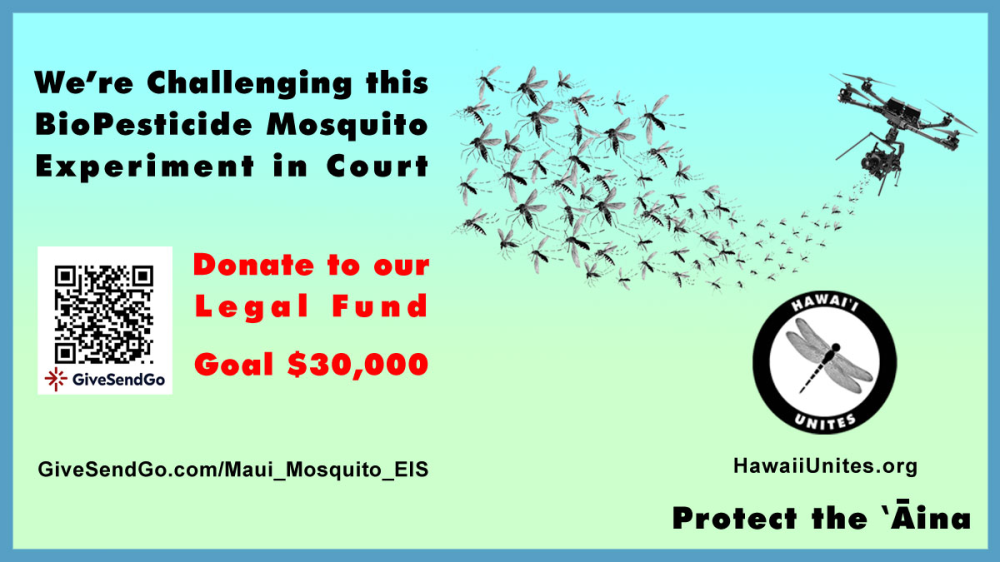
Prayer Requests
Click the Pray button to let the campaign owner know you are praying for them.
